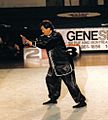Tai chi facts for kids
 |
|
|---|---|
| The lower dantian in Taijiquan: Yin and Yang rotate, while the core reverts to stillness (wuji). |
|

Yang Chengfu (c. 1931) in Single Whip posture of Yang-style t'ai chi ch'uan solo form
|
|
| Also known as | tàijí; t‘ai chi |
| Focus | Chinese Taoist |
| Hardness |
|
| Country of origin | China |
| Creator | Said to be Chen Wangting or Zhang Sanfeng |
| Famous practitioners |
|
| Olympic sport | Demonstration only |
Tai chi (Chinese: 太極; pinyin: Tàijí), also known as T'ai chi ch'üan or Tàijí quán (太極拳), is a special kind of Chinese martial art. People practice it for many reasons, like learning self-defense, improving their health, and for quiet meditation.
The name Taiji comes from a Chinese idea about how everything in the world works. It's about the balance of two opposite forces, yin and yang. The word 'quan' means 'fist'. So, Taijiquan means a fighting style based on this balance of opposites.
Even though Tai chi started as a way to fight, many people today use it for other things. Some enjoy competitive wrestling called pushing hands (tui shou). Others perform in demonstrations or practice to live a longer, healthier life. Because of these different goals, there are many ways to practice Tai chi, some old and some new. Many forms of Tai chi are famous for their slow, graceful movements.
Today, Tai chi is popular all over the world. Most modern styles of Tai chi come from one of five main traditional schools: Chen, Yang, Wu (Hao), Wu and Sun. All these styles can be traced back to a place called Chen Village in China.
Template:TOC limit=3
Contents
What is Tai Chi?
Tai chi is a unique martial art from China. It's known as an "internal" martial art. This means it focuses on inner strength, calm, and energy, rather than just outer muscle power. It combines slow, gentle movements with deep breathing and mental focus.
The Idea of Yin and Yang
The core idea behind Tai chi is Taiji, which means the "Great Ultimate." It describes how two opposite forces, yin and yang, are always connected and changing.
- Yin is often seen as dark, soft, slow, and feminine.
- Yang is seen as light, hard, fast, and masculine.
Tai chi movements help you understand and balance these forces within yourself.
Why People Practice Tai Chi
People practice Tai chi for many different reasons. It's not just about fighting. It offers many benefits for your body and mind.
Health Benefits
Tai chi is often called "moving meditation" because it's so good for your health.
- It can help you feel more relaxed and less stressed.
- The slow movements improve your balance and flexibility.
- It can also make your muscles stronger and improve your heart health.
- Many people find it helps them sleep better and feel more energetic.
Self-Defense and Martial Arts
Even though many people practice Tai chi for health, it is still a powerful martial art.
- It teaches you how to use your body's energy for defense.
- The slow practice helps you learn precise movements.
- Tai chi focuses on using your opponent's strength against them, rather than just brute force.
- One common training method is pushing hands (tui shou). This is a gentle way to learn how to feel and react to another person's movements.
Meditation and Focus
Tai chi is also a form of meditation.
- As you move, you focus on your breath and your body.
- This helps calm your mind and reduce distractions.
- It can improve your concentration and mental clarity.
- Many people feel a sense of peace and harmony after practicing Tai chi.
How Tai Chi is Practiced
Tai chi is usually practiced through a series of slow, flowing movements called "forms" or "sequences." These forms are like a dance, but each movement has a specific purpose, often related to self-defense.
Different Styles of Tai Chi
There are five main traditional styles of Tai chi. Each style has its own unique features, but they all share the same basic principles.
- Chen Style: This is the oldest style. It includes both slow, soft movements and sudden, explosive ones.
- Yang Style: This is the most popular and widely practiced style. It's known for its gentle, flowing, and expansive movements.
- Wu (Hao) Style: This style is less common and focuses on small, precise movements.
- Wu Style: This style is known for its compact movements and emphasis on balance.
- Sun Style: This style combines elements from other martial arts and features agile steps.
Training Methods
Besides forms, Tai chi training includes other exercises:
- Pushing Hands (Tui Shou): This is a partner exercise where two people gently push and yield to each other. It teaches sensitivity and balance.
- Standing Meditation (Zhan Zhuang): This involves holding specific postures for a period of time. It builds inner strength and focus.
- Weapons Forms: Some Tai chi styles also include forms with traditional weapons like swords or fans.
Tai Chi Around the World
Tai chi has become very popular globally. You can find classes and practitioners in almost every country. It's often practiced in parks, community centers, and martial arts schools. Many people enjoy practicing it outdoors in groups.
Related pages
Images for kids
-
Outdoor practice in Beijing's Temple of Heaven.
See also
 In Spanish: Taichí para niños
In Spanish: Taichí para niños










